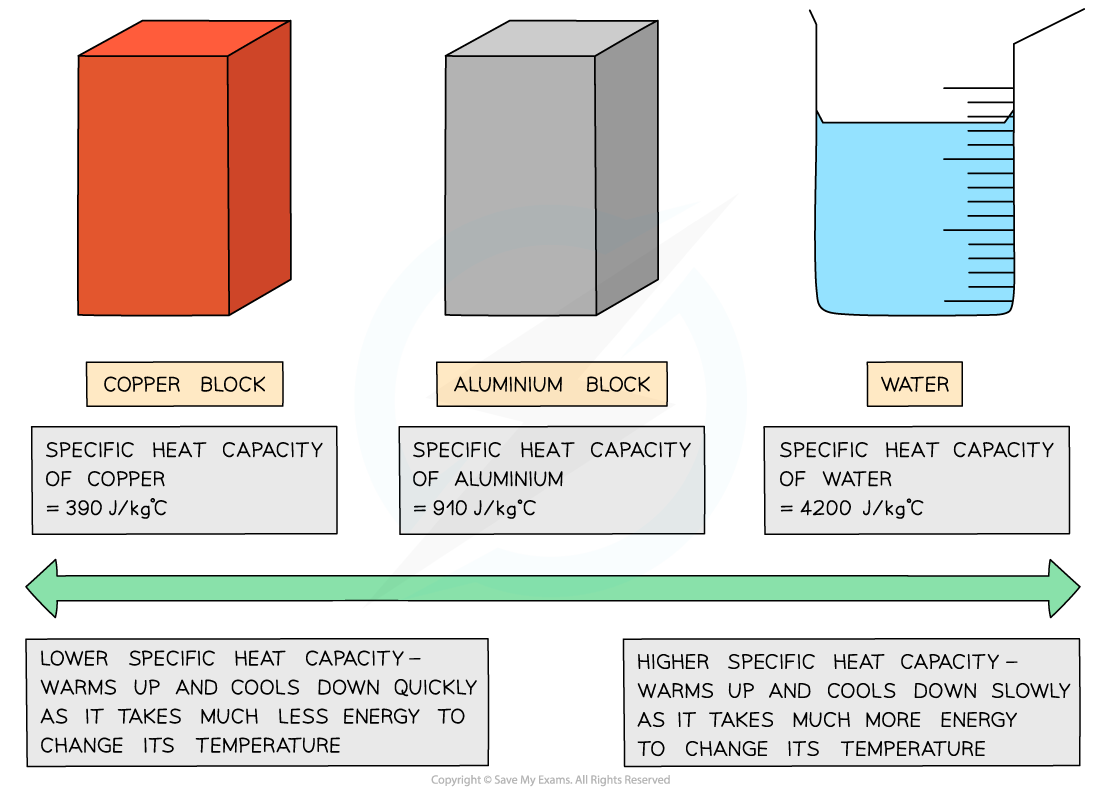Specific Heat Capacity (Cambridge (CIE) O Level Physics): Revision Note
Exam code: 5054
Internal Energy
A rise in the temperature of an object increases its internal energy
This can be thought of as due to an increase in the average speed of the particles
Increasing speed increases kinetic energy
Internal energy is defined as:
The total energy stored inside a system by the particles that make up the system due to their motion and positions
Motion of the particles affects their kinetic energy
Positions of the particles relative to each other affects their potential energy
Together, these two make up the internal energy of the system

Substances have internal energy due to the motion of the particles and their positions relative to each other
Average Kinetic Energy
Heating a system will change the energy stored in a system by increasing the kinetic energy of its particles
The Kelvin temperature of the gas is related to the average kinetic energy of the molecules
This increase in kinetic energy (and therefore energy stored in the system) can:
Cause the temperature of the system to increase
Or, produce a change of state (solid to liquid or liquid to gas)
The internal energy of a gas is the sum of the kinetic energy of all the molecules
The higher the temperature, the higher the average kinetic energy of the molecules and vice versa
This means they move faster
This applies to all states of matter, but the motion of particles in a solid is different to that of particles in a gas
If the temperature of a gas is increased, the particles move faster and gain kinetic energy
Therefore, they will collide more with each other and the container leading to an increase in pressure
The temperature (in Kelvin) is proportional to the average kinetic energy of the molecules
T ∝ KE
Worked Example
When a liquid evaporates, molecules escape from the surface of the liquid. What happens to the temperature of the liquid and the average kinetic energy of the molecules within it?
| Temperature | Average kinetic energy of molecules |
A | Increases | Increases |
B | Decreases | Decreases |
C | Stays the same | Decreases |
D | Decreases | Increases |
Answer: B
When evaporation takes place, the more energetic molecules are leaving the surface of the liquid
Since the more energetic molecules have left, the average kinetic energy per molecule must decrease
Therefore, A & D are not correct
Temperature is proportional to the average kinetic energy per molecule, therefore the temperature also decreases
Specific Heat Capacity
How much the temperature of a system increases depends on:
The mass of the substance heated
The type of material
The amount of thermal energy transferred in to the system
The specific heat capacity, c, of a substance is defined as:
The amount of energy required to raise the temperature of 1 kg of the substance by 1 °C
Different substances have different specific heat capacities
If a substance has a low specific heat capacity, it heats up and cools down quickly (ie. it takes less energy to change its temperature)
If a substance has a high specific heat capacity, it heats up and cools down slowly (ie. it takes more energy to change its temperature)

Low vs high specific heat capacity
Calculating Specific Heat Capacity
The specific heat capacity in terms of the amount of energy needed to raise the temperature of a given mass by a given amount can be calculated using the equation:
Where:
ΔE = change in thermal energy, in joules (J)
m = mass, in kilograms (kg)
c = specific heat capacity, in joules per kilogram per degree Celsius (J/kg °C)
Δθ = change in temperature, in degrees Celsius (°C)
Worked Example
Water of mass 0.48 kg is increased in temperature by 0.7 °C. The specific heat capacity of water is 4200 J / kg °C.
Calculate the amount of thermal energy transferred to the water.
Answer:
Step 1: Write down the known quantities
Mass, m = 0.48 kg
Change in temperature, ΔT = 0.7 °C
Specific heat capacity, c = 4200 J/kg °C
Step 2: Write down the relevant equation
Step 3: Calculate the thermal energy transferred by substituting in the values
Step 4: Round the answer to 2 significant figures and include the units
ΔE = 1400 J
Examiner Tips and Tricks
You will always be given the specific heat capacity of a substance, so you do not need to memorise any values.
However, it's useful to have the general idea that, the larger the number, the less the substance will increase in temperature for a given amount of heat.
You can see this for yourself in your own kitchen at home. Metal pans, which have a relatively low specific heat capacity get very hot, very quickly when put on the hob. Add water to the pan, which has a relatively high specific heat capacity and the water will take much longer to heat up.
Notice the units of specific heat capacity:
joules per kilogram per degree Celsius : J / kg °C
'per' means 'divided by'. We say 'per' in front of every value that is being divided by, hence 'per kilogram per degree Celsius'

Unlock more, it's free!
Did this page help you?